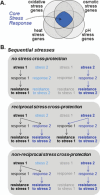Stress Adaptation
- PMID: 28721857
- PMCID: PMC5701650
- DOI: 10.1128/microbiolspec.FUNK-0048-2016
Stress Adaptation
Abstract
Fungal species display an extraordinarily diverse range of lifestyles. Nevertheless, the survival of each species depends on its ability to sense and respond to changes in its natural environment. Environmental changes such as fluctuations in temperature, water balance or pH, or exposure to chemical insults such as reactive oxygen and nitrogen species exert stresses that perturb cellular homeostasis and cause molecular damage to the fungal cell. Consequently, fungi have evolved mechanisms to repair this damage, detoxify chemical insults, and restore cellular homeostasis. Most stresses are fundamental in nature, and consequently, there has been significant evolutionary conservation in the nature of the resultant responses across the fungal kingdom and beyond. For example, heat shock generally induces the synthesis of chaperones that promote protein refolding, antioxidants are generally synthesized in response to an oxidative stress, and osmolyte levels are generally increased following a hyperosmotic shock. In this article we summarize the current understanding of these and other stress responses as well as the signaling pathways that regulate them in the fungi. Model yeasts such as Saccharomyces cerevisiae are compared with filamentous fungi, as well as with pathogens of plants and humans. We also discuss current challenges associated with defining the dynamics of stress responses and with the elaboration of fungal stress adaptation under conditions that reflect natural environments in which fungal cells may be exposed to different types of stresses, either sequentially or simultaneously.
Figures




Similar articles
-
Insights into the cellular responses to hypoxia in filamentous fungi.Curr Genet. 2015 Aug;61(3):441-55. doi: 10.1007/s00294-015-0487-9. Epub 2015 Apr 25. Curr Genet. 2015. PMID: 25911540 Review.
-
Phylogenetic diversity of stress signalling pathways in fungi.BMC Evol Biol. 2009 Feb 21;9:44. doi: 10.1186/1471-2148-9-44. BMC Evol Biol. 2009. PMID: 19232129 Free PMC article.
-
Our paths might cross: the role of the fungal cell wall integrity pathway in stress response and cross talk with other stress response pathways.Eukaryot Cell. 2009 Nov;8(11):1616-25. doi: 10.1128/EC.00193-09. Epub 2009 Aug 28. Eukaryot Cell. 2009. PMID: 19717745 Free PMC article. Review.
-
Fungal apoptosis: function, genes and gene function.FEMS Microbiol Rev. 2009 Sep;33(5):833-54. doi: 10.1111/j.1574-6976.2009.00180.x. Epub 2009 Apr 17. FEMS Microbiol Rev. 2009. PMID: 19416362 Review.
-
Stress-Activated Protein Kinases in Human Fungal Pathogens.Front Cell Infect Microbiol. 2019 Jul 17;9:261. doi: 10.3389/fcimb.2019.00261. eCollection 2019. Front Cell Infect Microbiol. 2019. PMID: 31380304 Free PMC article. Review.
Cited by
-
Morphological changes in response to environmental stresses in the fungal plant pathogen Zymoseptoria tritici.Sci Rep. 2019 Jul 3;9(1):9642. doi: 10.1038/s41598-019-45994-3. Sci Rep. 2019. PMID: 31270361 Free PMC article.
-
The impact of the Fungus-Host-Microbiota interplay upon Candida albicans infections: current knowledge and new perspectives.FEMS Microbiol Rev. 2021 May 5;45(3):fuaa060. doi: 10.1093/femsre/fuaa060. FEMS Microbiol Rev. 2021. PMID: 33232448 Free PMC article. Review.
-
Candida albicans pathways that protect against organic peroxides and lipid peroxidation.PLoS Genet. 2024 Oct 21;20(10):e1011455. doi: 10.1371/journal.pgen.1011455. eCollection 2024 Oct. PLoS Genet. 2024. PMID: 39432552 Free PMC article.
-
Influence of ylHog1 MAPK kinase on Yarrowia lipolytica stress response and erythritol production.Sci Rep. 2018 Oct 3;8(1):14735. doi: 10.1038/s41598-018-33168-6. Sci Rep. 2018. PMID: 30283045 Free PMC article.
-
Characterization of spatio-temporal dynamics of the constrained network of the filamentous fungus Podospora anserina using a geomatics-based approach.PLoS One. 2024 Feb 6;19(2):e0297816. doi: 10.1371/journal.pone.0297816. eCollection 2024. PLoS One. 2024. PMID: 38319941 Free PMC article.
References
-
- Hawksworth DL. 2012. Global species numbers of fungi: are tropical studies and molecular approaches contributing to a more robust estimate? Biodivers Conserv 21:2425–2433 10.1007/s10531-012-0335-x. - DOI
-
- de Hoog GS, Guarro J, Gene J, Figueras MJ. 2000. Atlas of Clinical Fungi, 2nd ed. Centraalbureau voor Schimmelcultures, Utrecht, The Netherlands/Universitat Rovira i Virgili, Reus, Spain.
Publication types
MeSH terms
Substances
Grants and funding
- 097377/WT_/Wellcome Trust/United Kingdom
- MR/M026663/1/MRC_/Medical Research Council/United Kingdom
- BB/K016939/1/BB_/Biotechnology and Biological Sciences Research Council/United Kingdom
- MR/N006364/1/MRC_/Medical Research Council/United Kingdom
- BB/K017365/1/BB_/Biotechnology and Biological Sciences Research Council/United Kingdom
LinkOut - more resources
Full Text Sources
Other Literature Sources
Medical

